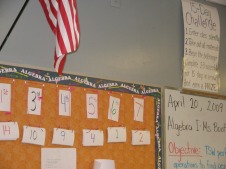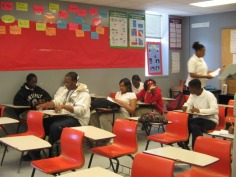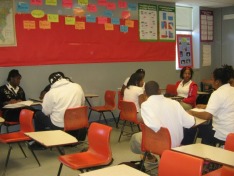Classroom Management
Technique #1 - Set Routines
I do NOT deal well with chaos. Controlled chaos is alright.
Knowing this about myself, I knew I had to make sure my classroom was well-organized. I quickly came up with system for keeping papers organized, and I quickly realized I needed a way to keep my students organized.
I don't mean finding a way to keep all of the students papers in order, but rather a way to keep the students themselves in order. If my students did not know what to do they did whatever they wanted to, and that results in true chaos.
I started out by setting up a simple morning routine. Everyday students would come in, sit down, take out their homework, and then start the bell-ringer. This gave me time to quickly take attendance and then collect homework while answering questions about the bell-ringer. I also had a built in reward for following the morning routine; after 15 days of following the routine, I would bring in cookies for the class.
Next came creating daily routines. I really only have two daily routines, independent days, and group days. Students knew what kind of day to expect if they walked in and found the desks in rows. On these days, they knew they would taking notes, doing guided practice problems on the board, and then working independently on practice problems. In contrast, if the students walked into a room with the desks grouped in threes, they knew to sit down with their groups and expected some sort of lab sheet or group project to do.
Importantly, these daily routines did not change the morning routine. Regardless of whether the desks were in rows or groups the students knew they still had to come in, sit down, take out their homework, and start the bell-ringer.
Another fantastic result of having these daily routines is that it dramatically cut down on the number of 'What are we doing today?" questions. I understand why students ask that question, but nonetheless hearing 30 times a day still drives me nuts.
Technique #2 - Students Make the Rules
I used this technique my second year with great success. On the first day of class, the bell-ringer was to define responsible, respectful, courteous, and honest in your own words. We spent some time writing everyone's ideas, and definitions up on the board, and I had a student copy down what was written on a sheet of paper.
At the end of the day, I took their words and definitions and created large concept maps along one of the walls in my classroom. These, student created, concept maps set the expectation for behavior in the classroom. Because the students themselves defined the words, they could not argue about how they were expected to behave. For the first few weeks I occasionally had to bring up our concept maps to defuse behavior, but after that it was not necessary.
I think it also helped, a lot, that I adhered to our class expectations as well. If I expected them to be responsible, respectful, polite, and honest, then they should expect the same from me.
Technique #3 - Clean Up
Another technique I have used for classroom management is making students care about the classroom environment, by showing them that I care. Whether people realize it or not, a place's importantance is judged by the physical reality of the room.
A person walking into a dirty, dark classroom automatically assumes that no one cares about the room and what happens in it. A person walking into a bright, colorful, clean classroom, assumes that someone does care about the room and what happens in it.
By keeping your environment clean you are showing respect for that environment and the people in that environment.
I started the year picking up paper and wiping down desks, and cleaning my board. I still pick up paper, and wipe down desks, and clean the board, but now so do my students. Keeping the room clean is about mutual respect. I respect my student and what they do in the classroom, so I try to keep it as pleasant as possible. The students respect me and what I do in the classroom, so they try to keep it as pleasant as possible as well.
Of course, this means I don't have to many problems with throwing paper, and writing on desks. I still have those problems occasionally, but the students ALWAYS pick up their paper with an apology, or ask for the cleaner to wipe the writing off their desks.
To go back to the home page click here.




